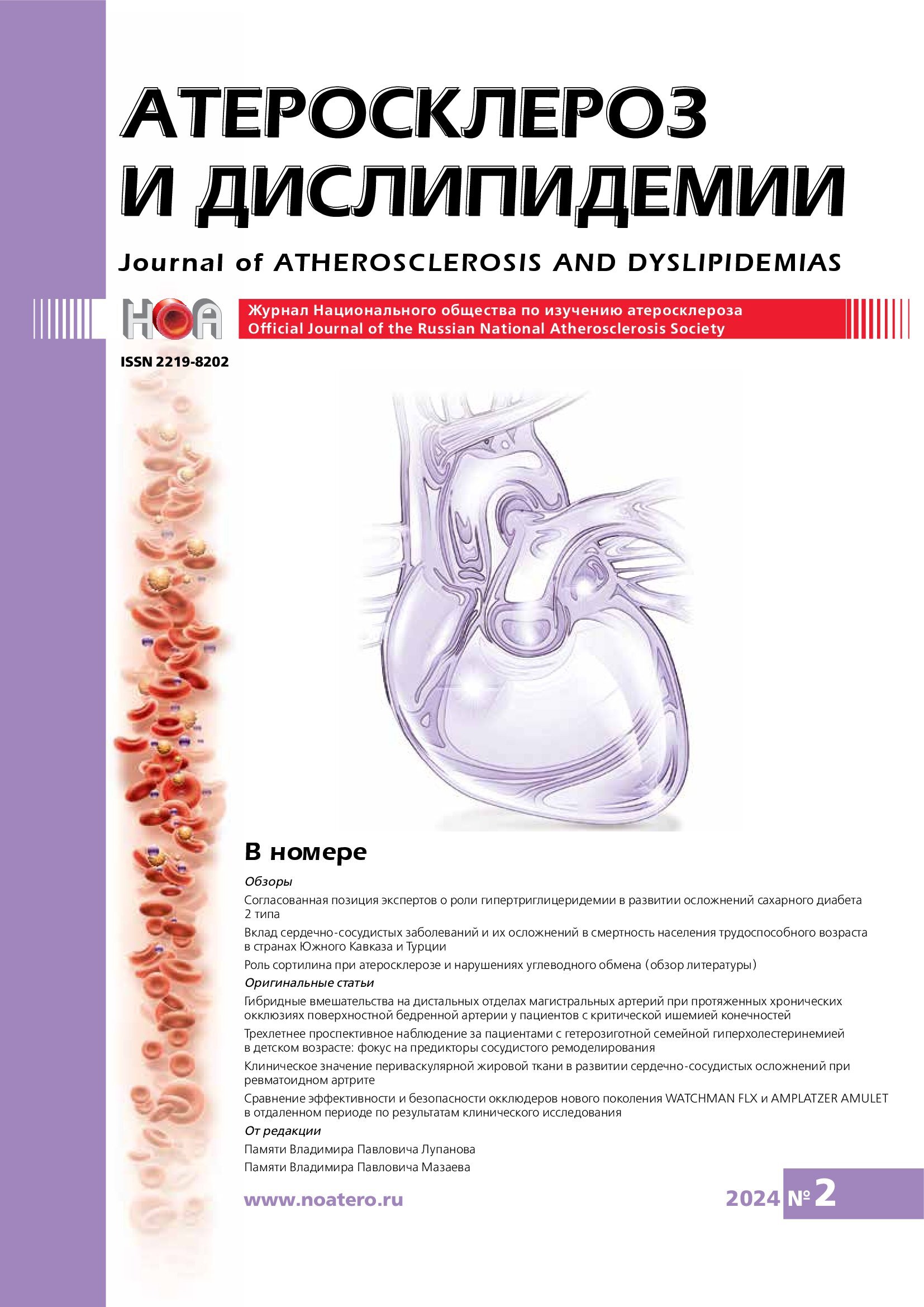Therapy with PCSK9 (alirocumab) inhibitors in patients with ischemic stroke in the Komi Republic
DOI:
https://doi.org/10.34687/2219-8202.JAD.2024.02.0002Keywords:
cardiovascular diseases, mortality, able-bodied population, countries of the South Caucasus, Turkey.Abstract
This article examines the place of cardiovascular diseases (CVD) in the structure of mortality on the example of three countries of the South Caucasus (Armenia, Azerbaijan, and Georgia) and Turkey. The populations of these countries have similar lifestyles and traditions, while the health care system and the socio-economic system accommodate their own characteristics. In all 4 countries, the top two causes of death among the working-age population are coronary heart disease (CHD) and cerebral stroke. The contribution of CHD to mortality ranges from 32% in Georgia to 42% in Azerbaijan. The contribution of cerebral stroke to mortality ranges from 10% in Armenia to 24% in Georgia. Every second man and up to 7% of women smoke. The prevalence of obesity and tobacco smoking among men in 4 countries is comparable. At the same time, in Georgia and Armenia, men drink alcohol 2-3 times more than in Turkey and Azerbaijan. The highest incidence of obesity was found among women in Turkey, at 39.2%. In the countries of the South Caucasus, a high incidence of obesity was found among women and, on average, amounted to 23.5%. The countries of the South Caucasus face a major challenge in reducing the incidence and secondary prevention of CVD among the adult population.
Downloads
References
Mensah, G, Fuster, V, Murray, C. et al. Global Burden of Cardiovascular Diseases and Risks, 1990-2022. J Am Coll Cardiol. 2023 Dec, 82 (25) 2350–2473. DOI: 10.1016/j.jacc.2023.11.007
Maslennikova G.Ya., Oganov R.G., Drapkina O.M. Modern global. regional and national priority strategic directions for the prevention and control of non-communicable diseases. Preventive medicine. 2020; 23 (2): 7-12. Russian (Масленникова Г.Я., Оганов Р.Г., Драпкина О.М. Современные глобальные. региональные и национальные приоритетные стратегические направления профилактики и контроля неинфекционных заболеваний. Профилактическая медицина. 2020; 23 (2): 7-12). doi: 10.17116/profmed2020230217
Priorities for primary and secondary prevention of chronic noncommunicable diseases (second edition). Ed. by Drapkina O. M. and Mamedov M. N., M. 2022. 144 p. Russian (Приоритеты первичной и вторичной профилактики хронических неинфекционных заболеваний (второе издание); Под ред. Драпкиной О. М., Мамедова М. Н., М. 2022, 144 с.).
Visseren F.L., Mach F., Smulders Y.M., et al. 2021 ESC Guidelines on cardiovascular disease prevention in clinical practice: Developed by the Task Force for cardiovascular disease prevention in clinical practice with representatives of the European Society of Cardiology and 12 medical societies With the special contribution of the European Association of Preventive Cardiology (EAPC), European Heart Journal. 2021. 42(34): 3227–3337. DOI: 10.1093/eurheartj/ehab484
World Health Organization, Global Health Estimates. https://www.who.int/data/gho/data/themes/mortality-and-global-health-estimates/ghe-leading-causes-of-death | Extracted: 22 November 2022
World Health Organization, Global Health Estimates. https://www.who.int/data/gho/data/themes/mortality-and-global-health-estimates/ghe-life-expectancy-and-healthy-life-expectancy | Extracted: 22 November 2022
Piché ME, Tchernof A, Després JP. Obesity Phenotypes, Diabetes, and Cardiovascular Diseases. Circ Res. 2020 May 22;126(11):1477-1500. doi: 10.1161/CIRCRESAHA.120.316101
Tokgozoglu L, Kayikcioglu M, Ekinci B. The landscape of preventive cardiology in Turkey: Challenges and successes. Am J Prev Cardiol. 2021 Apr 14;6:100184. doi: 10.1016/j.ajpc.2021.100184
Mamedov M.N., Deev A.D., Mehdiyev S.Kh. Priorities of primary prevention of cardiovascular disease: the results of multicenter international cohort study AHS I (Azerbaijan Heart Study, part I). International Heart and Vascular Disease Journal. 2018; 18: 4-14. Russian (Мамедов М.Н., Деев А.Д. Мехдиев С.Х. Приоритеты Приоритеты первичной профилактики сердечно-сосудистых заболеваний: результаты многоцентрового международного когортного исследования АHS I. Международный журнал сердца и сосудистых заболеваний. 2018. 18(4): 4-14). doi: 10.24412/2311-1623-2018-18-4-14
Fazeli ME, Tadevosyan A, Fallahi E, et al. Nutritional factors and metabolic variables in relation to the risk of coronary heart disease: A case control study in Armenian adults. Diabetes Metab Syndr. 2017 Jan-Mar;11(1):7-11. doi: 10.1016/j.dsx.2016.06.013.
Lui M, Safiri S, Mereke A, et al.Burden of Ischemic Heart Disease in Central Asian Countries, 1990-2017. Int J Cardiol Heart Vasc. 2021 Feb 7;33:100726. doi: 10.1016/j.ijcha.2021.100726
Downloads
Published
How to Cite
Issue
Section
License
Copyright (c) 2024 М. Н. Мамедов, Г. Г. Арабидзе

This work is licensed under a Creative Commons Attribution 4.0 International License.























